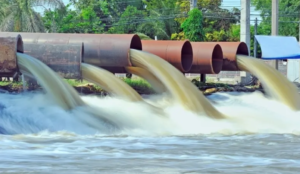Toilet Paper a ‘Significant Source’ of Toxic PFAS Chemicals in Wastewater
What we flush down the toilet could be making us sick, according to a recent study.
Toilet paper could be a significant source of toxic “forever chemicals” in wastewater, according to research published in the journal Environmental Science & Technology Letters.

The findings raise public health concerns since wastewater and its by-products are frequently spread on agricultural fields to help grow crops.
Per- and poly-fluoroalkyl substances, also known as PFAS, are a class of chemicals used for their waterproofing and stain-resistant properties.
They have been linked to certain cancers, reproductive problems and developmental issues, and are known as “forever chemicals” since they don’t break down in the environment.
Scientists have known for years that wastewater is a slurry of PFAS from all different sources — soaps, makeup and residues on clothing can all contain PFAS, which is washed down the drain every time someone showers or washes their clothes.
But though PFAS are used in toilet paper manufacturing, toilet paper’s contribution to PFAS contamination in wastewater has been under-studied, according to the paper’s authors.
“When people think about wastewater and wastewater sludge, they’re thinking about maybe industrial discharges, or they might be thinking about all these personal care products. Our point here is just don’t neglect the very one thing that is going down into the sewer system everywhere,” said Timothy Townsend, a professor of environmental engineering at the University of Florida and an author on the study.
According to one 2018 study, toilet paper makes up about 72% of the solid material in wastewater, so it’s not surprising that it could be a big contributor to PFAS in wastewater, too.
In the recent study, researchers in Townsend’s lab tested the PFAS levels in 21 different toilet paper samples from across the globe. They found concentrations of PFAS in all 21 samples.
One type of PFAS, called 6:2 diPAP, was most prevalent, making up 91% of the PFAS chemicals in the samples. The results did not show much difference in PFAS concentration between the toilet paper samples, or between recycled and regular toilet paper.
The researchers also tested samples of wastewater sludge, and found that the chemical was similarly prevalent in wastewater, suggesting in the paper that toilet paper “should be considered as a potential significant source of PFAS entering wastewater treatment systems.”
The findings have public health implications, since the byproducts of wastewater sludge are processed and sold as agricultural additives, sometimes called biosolids, which farmers then spread on fields.
A 2022 analysis by the Environmental Working Group estimated that 5% of agricultural fields in the U.S. — making up nearly 20 million acres — use sewage sludge as fertilizer. The PFAS in that sludge can contaminate some agricultural products that humans then consume, according to researchers.
The U.S. Environmental Protection Agency (EPA) does not currently require land-applied biosolids to be tested for PFAS.
That could change as research compiles, said Townsend. “I imagine that EPA is going to have to step back and look at the evidence and the data that are out there. And they’re going to have to make a determination about whether PFAS needs to be factored in.”
Toilet paper is “a large enough contributor that when it comes to trying to make decisions about what we can possibly do to address [the PFAS in wastewater] issue, it needs to be considered,” he said.
yogaesoteric
April 10, 2023
Also available in:
 Français
Français
